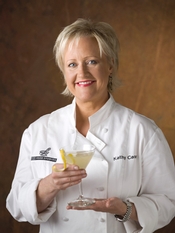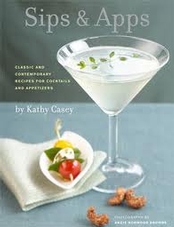The venue is Austin, Texas, the event is the annual conference of the International Association of Culinary Professionals (IACP), the time is last weekend. Since I am woefully undereducated about bitters, I thought a workshop entitled “It’s Better to be Bitter: The Hows and Whys of Bitters” would fun to attend. But the foremost bitter truth about bitters this morning is this: My plane was delayed, so I’ve arrived at the workshop an hour late.
As I slide into my seat in the crowded conference room my enthusiasm definitely wanes. Lined up in front of me are six shot glasses filled with various bitters. They’re certainly colorful, but I’m not sure what I’m supposed to do with this assortment of liquids. The only ones I’ve heard of are Angostura and Pechaud (this one is neon red, like Campari). My fellow bitters participants are merrily mixing together various combinations of these potions with Ginger Ale or club soda, or layering them in various combinations, but since I’ve missed the explanatory part of the session I have no idea what the goal of this exercise is. My spirits lift when we’re each given a glass filled to the brim with rye whiskey, Noilly Prat red vermouth, St. Germain and a dash of bitters. These bitters were made by Kathy Casey, a Seattle based cocktail and beverage program consultant who is leading the workshop. She point out that the charm of this particular Manhattan is the St. Germain. “The elderberry in St. Germain softens the entire effect,” she explains. I take a couple of sips. Did that pleasurable purring sound come from me? Note to self: Buy a bottle of St. Germain.
dash of bitters. These bitters were made by Kathy Casey, a Seattle based cocktail and beverage program consultant who is leading the workshop. She point out that the charm of this particular Manhattan is the St. Germain. “The elderberry in St. Germain softens the entire effect,” she explains. I take a couple of sips. Did that pleasurable purring sound come from me? Note to self: Buy a bottle of St. Germain.
I start to take notes from the Power Point visuals on how to make bitters at home: Start with a base of high alcohol, either neutral (vodka, for example), or one that will add its own flavor (rum is typical). Put in some aromatics such as spices, coffee, tea, and/or herbs. Add the bittering agent, typically gentian, cinchona, angelica root, burnt sugar, and/or citrus peels. At this point I am briefly distracted by the deliciousness of my Manhattan, which is how I happen to forget to copy down the part about filtering your bitters. I’m sure that Kathy says something to the effect that using a coffee filter makes it a very long procedure. I’ll have to double check about this on her website.
Someone in the audience asks if cocktails are good with food. “Cocktails are totally being paired with food these days,” Kathy responds enthusiastically. “I’m especially happy about this because bringing the kitchen into the bar has always been my goal.” I find myself lost in thought about all the foods that might go with Manhattans, but I’m brought back to the present when I realize Kathy is discussing another current trend: Barrel aged bitters. “In fact, it isn’t just bitters that are being aged. Aging entire cocktails in oak is a major trend today,” she assures us, citing as an example of this her recent experience with a Negroni (gin, sweet vermouth and Campari) that had been aged three months in an oak barrel. “It was fantastic!” Personally, I’m glad the Manhattan I’ve been savoring hasn’t been barrel aged–it’s fantastic just the way it is.
One important thing I learn this morning is the difference between shaking and stirring a cocktail. “A cocktail that’s all spirits is usually stirred,” Kathy tells us. “A cocktail with juice or other ingredients like that is supposed to be shaken. Shaking aerates the drink and makes it opaque.” Then she adds: “But I never follow the rules. I like my martinis shaken.”
Noting my empty glass, the woman sitting on my right offers me what’s  left of her Manhattan. I glance at my watch: eleven-thirty in the morning. Maybe not. Instead, I resolve to buy a copy of Kathy Casey’s book “Sips and Apps: Creative Cocktails, Inspired Classics and Timeless Appetizers” (Chronicle Books). The Manhattan recipe is in it, and I could also learn how to make my own Green Eye Daiquiri, an “inspired classic” that calls for fresh thyme, rum, Chartreuse, fresh lime juice and sugar. Or I could whip together some Riesling and Midori Melon Liqueur and garnish it with lime slices and watermelon to create my own Summer Melon Sangria, perfect for a party. But the “Sips and Apps” cocktail that most intrigues me is the Red Square Martini, which calls for vodka, dry vermouth, and a thinly sliced beet (it turns the drink red). Garnished with lemon rind, a tiny slice of smoked salmon, and a sprig of fresh dill, this might be almost as good as a Manhattan.
left of her Manhattan. I glance at my watch: eleven-thirty in the morning. Maybe not. Instead, I resolve to buy a copy of Kathy Casey’s book “Sips and Apps: Creative Cocktails, Inspired Classics and Timeless Appetizers” (Chronicle Books). The Manhattan recipe is in it, and I could also learn how to make my own Green Eye Daiquiri, an “inspired classic” that calls for fresh thyme, rum, Chartreuse, fresh lime juice and sugar. Or I could whip together some Riesling and Midori Melon Liqueur and garnish it with lime slices and watermelon to create my own Summer Melon Sangria, perfect for a party. But the “Sips and Apps” cocktail that most intrigues me is the Red Square Martini, which calls for vodka, dry vermouth, and a thinly sliced beet (it turns the drink red). Garnished with lemon rind, a tiny slice of smoked salmon, and a sprig of fresh dill, this might be almost as good as a Manhattan.
7
